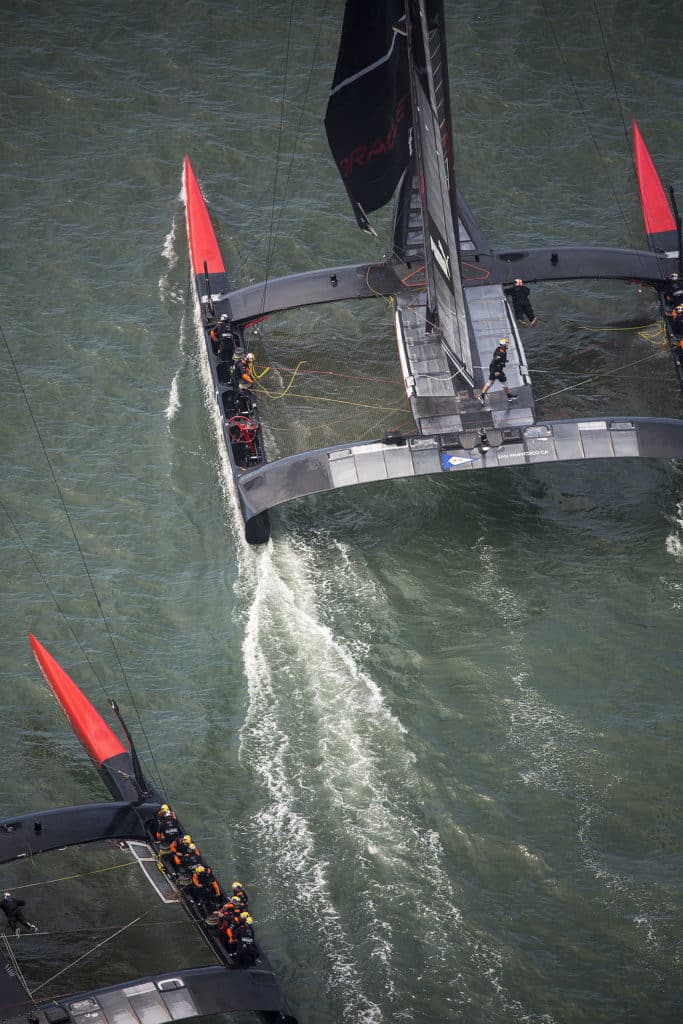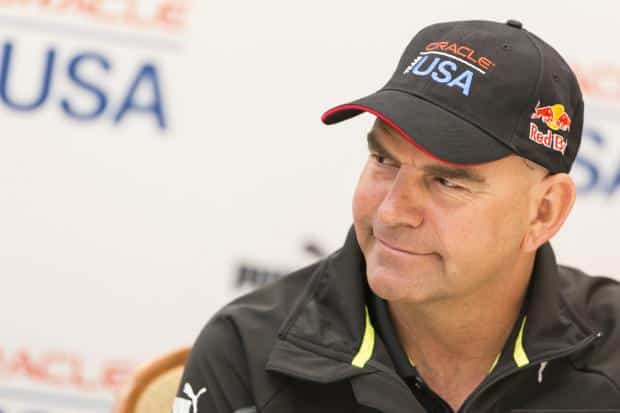
Oracle Team USA Trials
With the 34th America’s Cup match racing final less than two weeks away, the anticipation is palpable—who is faster? The well-seasoned Kiwis who have made so few mistakes in their conquest of the Louis Vuitton Cup, while also charming the pants off the sailing fans and spectators with their slick maneuvers and team spirit? Or will it be the Americans, who’ve had the good fortune of ample resources throughout their campaign, but who are now knee-deep in muck over allegations of cheating, which could cost them races and top crewmembers? It doesn’t seem to matter who you talk to, the answer’s the same: Race 1 will tell all.
We check in with John Kostecki, one of America’s most highly regarded sailors and the tactician for Oracle Team USA, to see what’s been going on at the Oracle camp:
What did the challenger racing reveal to you? What did you learn?
JK: ETNZ is impressive. They look really strong in their crew maneuvers. They seem to gain a lot there. We study those moves to try to learn and improve. We look at different helicopter shots and shots from on board; we study those as much as we can. Things that they’re doing well we want to learn why and try to apply that to our sailing.
What particularly impresses you?
JK: Their jibing and their tacking. As you’ve seen, you can gain hundreds of meters in one jibe. They’re very consistent out there. Probably we still have a ways to go to catch up to them in that.
Do you really think so?
JK: Yeah, I think so. In some conditions our consistency isn’t quite as good as theirs at the moment. They’ve had the same group of sailors for a long time. We have a big group here. Just recently we’ve gone with more of a racing team and a back-up team, splitting that onto the two boats, so we’re still learning each day when we’re out together. That’s a little bit of a factor. I’m not saying we can’t get there, we still have up to seven more sailing days. Hopefully, we’ll do a few two-boat days also.
Why wouldn’t they all be two-boat days at this stage?
JK: Logistically, it’s really hard to sail, maintain, launch. It’s a major drain on the whole team to do that. Ideally, every day would be a two-boat day, but logistically it’s hard and tiring; resource-wise maintaining two boats is really hard. Maintaining one boat is really hard. We need to do it, but it’s hard.
Local knowledge is your expertise. Tell us how conditions will be different in September here versus what we’ve seen in the LV Cup?
JK: It’s pretty far out to predict precisely, but at this time of year, San Francisco starts to change normally. Yesterday [last day of LV Final] was a different day already. We start going into a more fall-type of pattern: lighter air with less sea breeze. The first four days of racing are going to be in a more flood-type of current, which will bring the winds down some and make it more time upwind than average and less time downwind on average than a normal slack tide. Lighter breeze and smoother water.
You got to observe ETNZ in a range of conditions: lessons?
JK: Only yesterday did we get to see them race in lighter air. It’s all been pretty heavy breeze, so we were happy to see them in one light race to get a feeling of our performance against theirs. The initial look is encouraging for us that way. They look really good in a stronger breeze. I would hope that we have an advantage in lighter wind.
You’re more optimized for lighter breeze then?
JK: Well, yes and no. Now with the lower windspeed limits plus or minus current [23 knots for the match], we’re trying to optimize within 8-20 knots [laughs] which is a pretty wide range. That’s what we’ll get during the Cup, and I’m sure that’s what the Kiwis are optimized for. I don’t think any team has a huge advantage either way—maybe we’re a little towards lighter air and they’re a little more towards the higher breeze.
Have you been able to get much light air training in?
JK: Not really. We haven’t really seen code zero conditions, but we’re hoping we do between now and the Cup so we can get a few training days in with the zero. There’s a really good chance we’ll see at least a few legs—it could be less than half the regatta—where you’d be using the code zero. We’re trying to use it more and get comfortable with it. The crossover for the code zero is around 10-12 knots, and anything over that you’re not on it.
How do you collect and understand data from ETNZ?
JK: The racing data is good because we have their boatspeeds and all their speeds—its GPS speeds so its over ground—then you have to calculate the current, etc. We do that ourselves and have a pretty good idea of what their performance is like through the racing. The racing’s been good to watch, as it’s harder when they’re on their own and not racing to get a really good idea of what they’re doing.
Have you emulated the speeds ETNZ have reached?
JK: I take some of that really lightly because I don’t have the hard facts because it might be speed over ground. I’d say what’s been broadcast over TV is speed over ground. If you’re going downwind at 40 knots, you have 3 knots of flood—there’s 43 knots right there. I’d really need more information to believe they’ve done 48 knots, but I think we’ve been close to that for a top speed.

John Kostecki, Photo: Guilain Grenier/Oracle Team USA
Do you have a sense whether ETNZ still have something in the bag?
JK: No, I don’t think they have anything that’s big—there’s always little things, and they’ve been working on upwind foilin,g and they’ve seen us upwind foiling so it’s no real surprise, but I think they’re trying to keep it quiet. I think they were a little disappointed that way back when they started foiling downwind they leaked that as quick as they did. I’ll bet they wish they’d held that closer. Now with the upwind foiling, I can tell anytime we’re around them they don’t do it, they try to hide it. But it’s pretty obvious they’re doing it, and we’re doing it. I think you’ll see some of it in the race if it’s the right conditions.
What are the right conditions for upwind foiling?
JK: You need a certain windspeed—I’ve seen them doing it in 15 knots of wind, so that seems to be somewhere around the bottom of it where it becomes pretty quick. It’s trickier to maintain an upwind foil just because we haven’t been practicing it—I think for both teams it’s harder.
There’s been a lot of discussion about how unsuitable the racecourse is for these boats, with very limited opportunities to pass.
JK: Not much has changed there—it’s how the AC45 World Series was. The start, the first reach, and the first jibe seem to be very critical, so we’re putting a lot of weight into that. I know the Kiwis are as well. If you can get out of the blocks well and down to the first mark and round the gate first, it’s going to be hard to pass. But, you can pass. There are opportunities, it’s a sailboat race!
Are you anticipating that we’ll see more true match racing?
JK: I think so—I think we’ll have closer racing than we’ve seen out there. I’m really looking forward to it! I think we need it after the LV Cup, as the press has been so negative about it.
How are you guys keeping it together with all the negative press around “Weight-Gate” and general anti-Oracle sentiment?
JK: We talk about it as a team all the time. We really try to stay focused, and I think we’re doing a very good job of that. Yeah, we do have our distractions, which is unfortunate, but it’s always been part of the game—it’s the America’s Cup. The good thing is the depth and experience on this team, people who’ve sailed a number of America’s Cups, winning and losing, and have seen a lot of this stuff that is going down now previously. We’re using that experience to help us through these tough times.
What’s the plan if you don’t survive “Weight-Gate” fully intact?
JK: We’re fortunate that we have two fully crewed 72s now—we’re quite strong and pretty deep that way. We have strong back-ups in every position. Whatever happens I think we’ll be ok.









